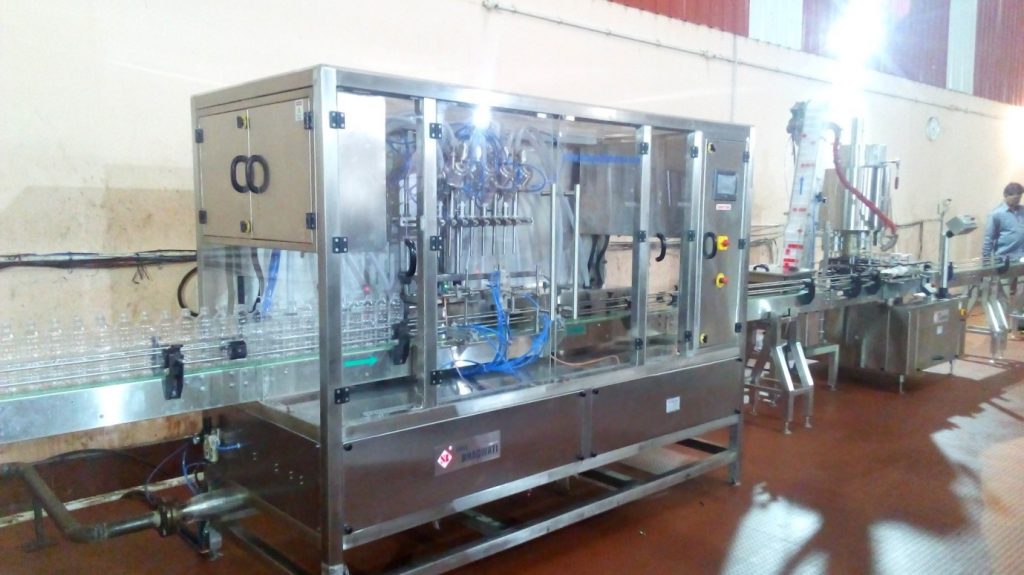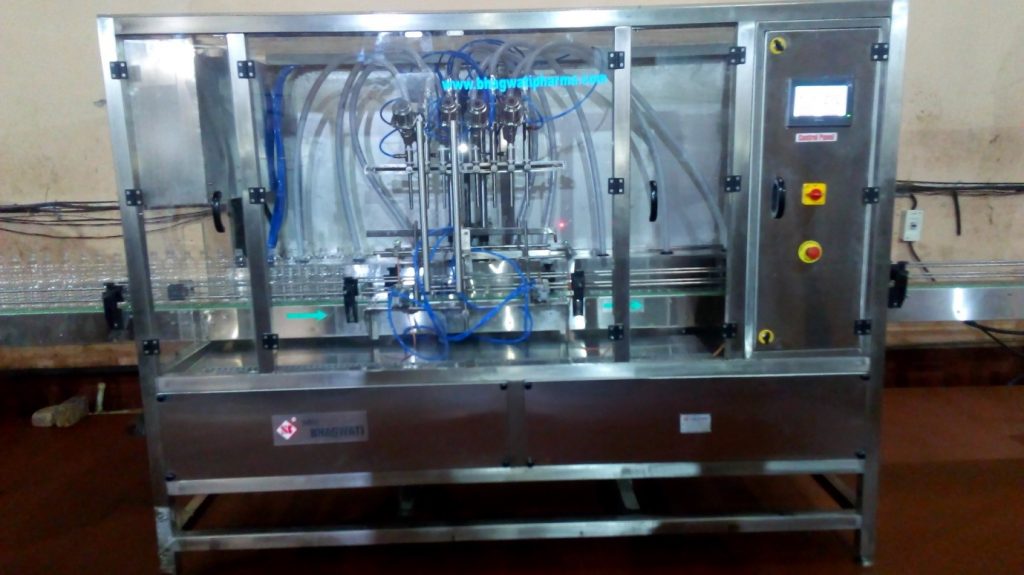FLOW METER AND GEAR PUMP FILLING MACHINE
A flow meter is a device used to measure the volume or mass of a gas or liquid. Flow meters are referred to by many names, such as flow gauge, flow indicator, liquid meter, flow rate sensor. depending on the particular industry. However, they all measure flow. Open channels, like rivers or streams, may be measured with flow meters. Or more frequently, the most utility from a flow meter and the greatest variety of flow meters focus on measuring gasses and liquids in a pipe. Improving the precision, accuracy, and resolution of fluid measurement are the greatest benefits of the best flow meters.
A flow meter is used in different types of applications to measure the volumetric flowrate or mass flowrate. The specific application defines the type and capacity of the flow meter. Fluids, gases and liquids, are measured in terms of volumetric flowrate and mass flowrate. Both are related to material’s density with volumetric flowrate denoted by Q and mass flowrate by ṁ in the equation ṁ=Q x ρ.
The Flow meters has a various types
- Differential Pressure Flow Meters
Differential pressure flow meters measure the differential pressure across an orifice where flow is directly related to the square root of the differential pressure produced. There are also primary and secondary elements in differential flow meters.
- Positive Displacement Flow Meters
Positive displacement (PD) flow meters measure the volume filled with fluid, deliver it ahead and fill it again, which calculates the amount of fluid transferred. It measures actual flow of any fluid while all other types of flow meters measure some other parameter and convert the values into flowrate.
- Velocity Flow Meters
Velocity meters measure velocity of the stream to calculate the volumetric flowrate. These are less sensitive when the Reynolds number of fluid is higher than 10000. Velocity flow meters include turbine, paddlewheel, vortex shedding, electromagnetic and sonic/ultrasonic flow meters.
- Mass Flow Meters
Mass flow meters are more effective in mass related processes as they measure the force that results from the acceleration of mass. More specifically, the force is measured as the mass moving per unit of time, instead of the volume per unit of time. Mass flow meters include Carioles mass meters and thermal dispersion meters.
- Open Channel Flow Meters
Measurement of liquid in open channels includes v-notch, weirs and flumes. These dam-like structures, or overflows, allow for a limited or concentrated free-flow of liquids based on the unique shape and size of the structure. This type of flow meter allows for a reading of the flowrate to be calculated.


A flow meter is a device used to measure the volume or mass of a gas or liquid. Flow meters are referred to by many names, such as flow gauge, flow indicator, liquid meter, flow rate sensor. depending on the particular industry. However, they all measure flow. Open channels, like rivers or streams, may be measured with flow meters. Or more frequently, the most utility from a flow meter and the greatest variety of flow meters focus on measuring gasses and liquids in a pipe. Improving the precision, accuracy, and resolution of fluid measurement are the greatest benefits of the best flow meters.
A flow meter is used in different types of applications to measure the volumetric flowrate or mass flowrate. The specific application defines the type and capacity of the flow meter. Fluids, gases and liquids, are measured in terms of volumetric flowrate and mass flowrate. Both are related to material’s density with volumetric flowrate denoted by Q and mass flowrate by ṁ in the equation ṁ=Q x ρ.
The Flow meters has a various types
- Differential Pressure Flow Meters
Differential pressure flow meters measure the differential pressure across an orifice where flow is directly related to the square root of the differential pressure produced. There are also primary and secondary elements in differential flow meters.
- Positive Displacement Flow Meters
Positive displacement (PD) flow meters measure the volume filled with fluid, deliver it ahead and fill it again, which calculates the amount of fluid transferred. It measures actual flow of any fluid while all other types of flow meters measure some other parameter and convert the values into flowrate.
- Velocity Flow Meters
Velocity meters measure velocity of the stream to calculate the volumetric flowrate. These are less sensitive when the Reynolds number of fluid is higher than 10000. Velocity flow meters include turbine, paddlewheel, vortex shedding, electromagnetic and sonic/ultrasonic flow meters.
- Mass Flow Meters
Mass flow meters are more effective in mass related processes as they measure the force that results from the acceleration of mass. More specifically, the force is measured as the mass moving per unit of time, instead of the volume per unit of time. Mass flow meters include Carioles mass meters and thermal dispersion meters.
- Open Channel Flow Meters
Measurement of liquid in open channels includes v-notch, weirs and flumes. These dam-like structures, or overflows, allow for a limited or concentrated free-flow of liquids based on the unique shape and size of the structure. This type of flow meter allows for a reading of the flowrate to be calculated.
Flow meter gear pump or net weight filling technology.
Industry: Pharmaceutical, Biotechnology, Cosmetic, Food/Beverage, Healthcare, Personal Care, Chemical Specialty, Diagnostics, Veterinary
Product: Viscous, Semi-viscous, Water Thin, Lotion, Cream, Gel, Particulate Laden Material, Shampoo, Laundry Detergent flow, volume flow, density, fraction and temperatur
Gear Pump Filling Machines
The gear pump filling machine is suitable to fill thin liquid like lubricating oil, shampoo, lotions. It has big machine features in compact design with electronically change fill volume in seconds with easy to read LED digital display. The gear pump filling machine uses a gear pump concept as a metering device to fill correct amounts of liquids into containers. Each revolution or part revolution of pump delivers an exact amount of product into the container. The amount delivered is controlled by an electronic counter.
We are the preeminent Manufacturer and Exporter of Gear Pump Filling Machines, which are diligently designed by the skilled engineers. They have incorporated various efficiency-increasing features in our Gear Pump Filling Machines, which have assured the clients in regard of their ability to perform in the hard-core industrial applications.
The automatic electronic liquid filling machine is compact and highly efficient machine with elegant look. This multi-function multi featured machine meets the custom requirements of filling for glass, plastic and aluminium bottles. The machine has its own pumping system to connect the machine with main tank. The flow of liquid is measured and converted in to electronic signals being controlled by microcomputer base circuitry. Minimum adjustment required to set different capacities from 5 litres to 15 litres with varying containers. The entire range can be set on the same machine without any change parts.
The filling pump synchronized with conveyor drive and conveyor drive controlled by AC frequency drive. The speed can be set in terms of bottles per minute. The conveyor drive consists of a hollow shaft, geared motor controlled by AC frequency drive. A knob can set the speed of conveyor. Shree Bhagwati group has Installed various Filling Machines like Filling machine for Cream Paster, Butter, Castor Oil, Cheese, Chocolate, Coconut oil,, Fruit juice, Fruit pulp, Glucose, Glycerine, Honey, Jams, Jelly, Ketchup, Liquid sugar, Lotions, Milk, Molasses, Nail polish, varnish, Olive oil, Palm oil, Pastes, Liquid Soap, Solvents, Sorbitol syrup, Soup, Tomato paste, Tomato ketchup, Toothpaste, Vaseline, Vinegar, Yogurt, Paint, Gum, Adhesive, Ghee, Liquid Hand, Hand Wash, Furnace Oil, Mineral Oil, Chemicals, Petroleum Jelly, Ink, Effluent Treatment, Crude Oil, HFO, Oil, Waste Oil, Grease, Gels, Lubricating Oil Filling machine , Hydraulic Oil, Bitumen, Turbine Oil, Asphalt Filling machine application in Cosmetic, Pesticide, Chemical, Food & beverage industries.
Main Features
- Robust construction, heavy duty base, S.S. elegantly matt finished body.
- No Change parts require filling different fill size.
- 2/4/6 Filling stations, space saving design.
- Accuracy ± 0.25 % at any one desire volume Easy to clean.
- Pneumatically controlled nozzles, with ‘No container no fills’ arrangement.
- Pneumatically operated bottle stopper.
- PLC controlled latest technology.
Global Demand of Flow Meter and Gear Pump Filling Machine


Gear Pump Filling Machine market report is a blend of statistical figures, facts and data that are derived out of extensive research by a bunch of professional analysts. The report contains chapter wise content on every aspect of the market offering a comprehensive analysis. Data analytics and data mining techniques have been adhered to, so that the clients can form a subtle opinion prior heading for a detailed market report.
This report focuses on Gear Pump Filling Machine volume and value at global level, regional level and company level. From a global perspective, this report represents overall Gear Pump Filling Machine market size by analysing historical data and future prospect. Regionally, this report focuses on several key regions: North America, Europe, China and Japan.
At company level, this report focuses on the production capacity, ex-factory price, revenue and market share for each manufacturer covered in this report.
The global flow meter market size is estimated to reach USD 11.05 billion by 2025, according to the new report conducted by Grand View Research, Inc., expanding at a CAGR of 5.98% during the forecast period. Rising penetration of IoT is escalating the demand for smart flow rate measurement solutions, which is turn is stoking the demand for intelligent flow meters. Rapid urbanization is augmenting the need for better water & wastewater management. This, along with technological advancements that are enhancing the accuracy and reliability of flow meters, is working in favor of the market.
